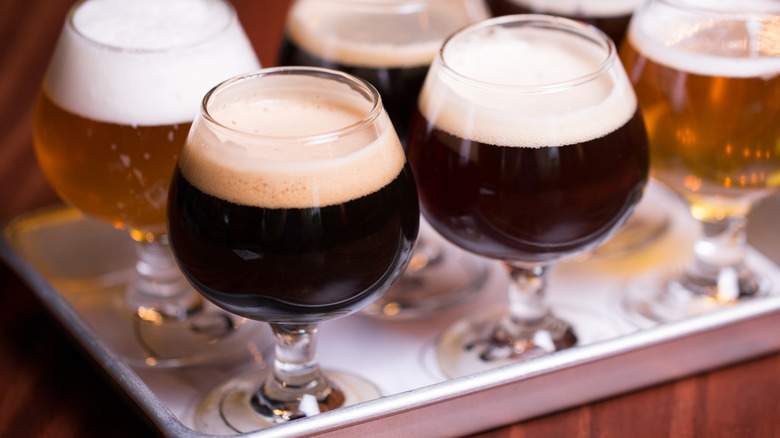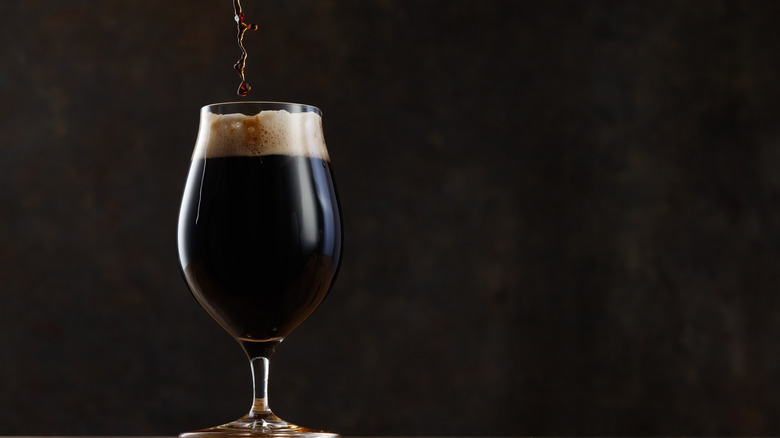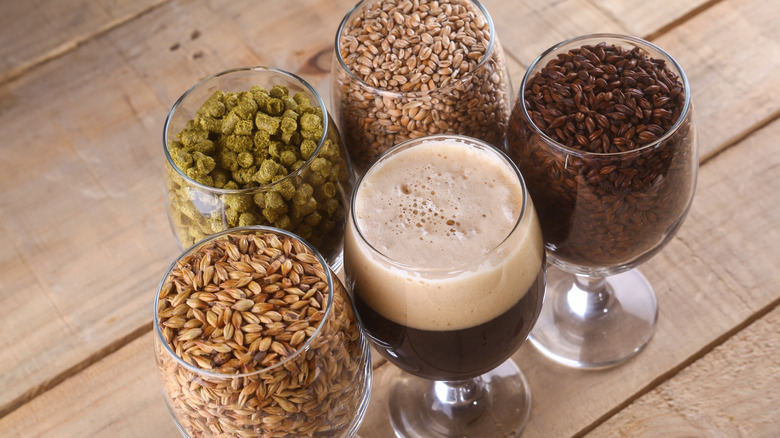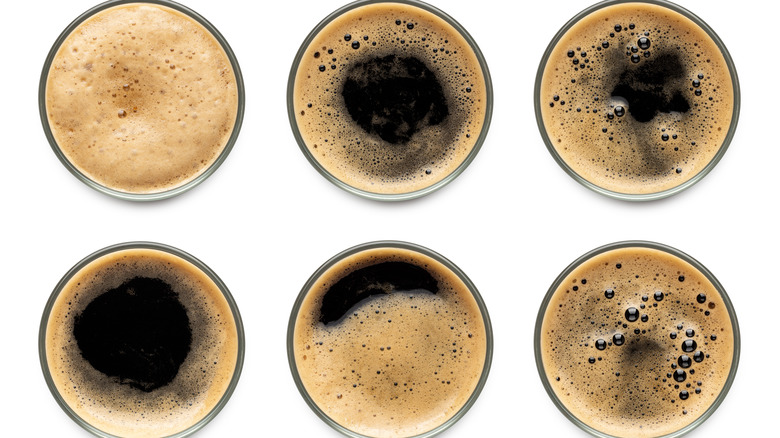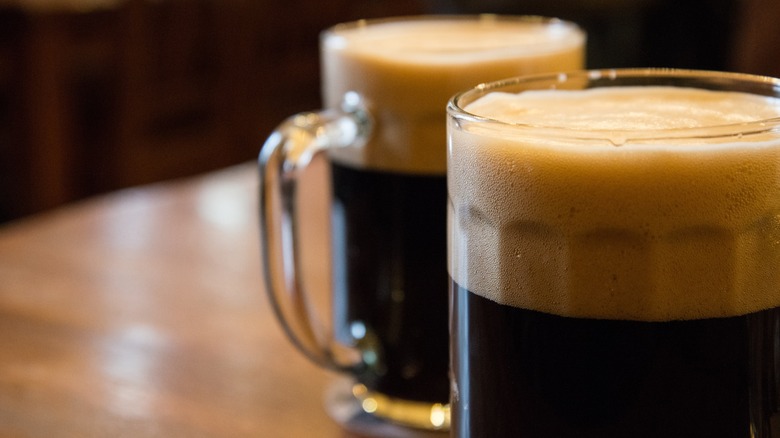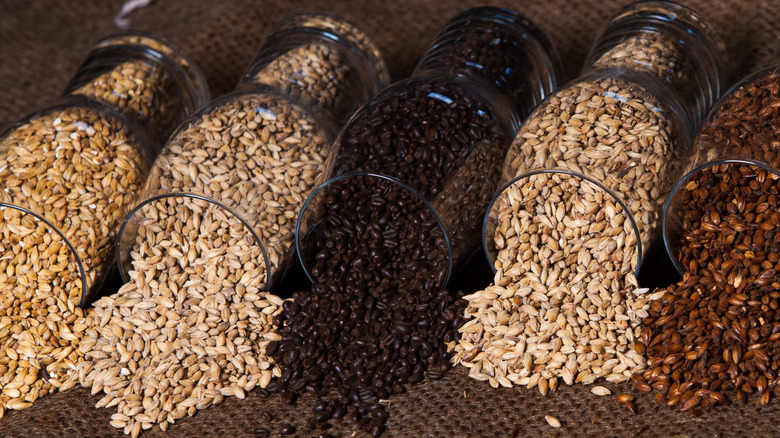Is There A Real Difference Between Stouts And Porters?
The majority of the time, standard-fare domestic beers and hoppy IPAs take much of the spotlight. But as time rolls on, craft beer and its wide varieties and subclasses are becoming more popular. A recent surge in the consumption of hard ciders, spiked seltzers, sour beers, and wacky-flavored sips has also increased the range of palettes available, including the enjoyment of rich porter and stout beers.
If you're not familiar yet, you can recognize porters and stouts by their dark, typically brown coloring. They're often brewed with flavor notes like chocolate, coffee, peanut butter, and other sweet, spicy essences. And, often enough, the two can be confused as being the same. But are they really?
The truth is, there isn't one big, simple answer regarding the key differences between a porter and a stout; but what many beer connoisseurs consider to be the determining factors include the variants in foam head color, flavor intensity, and acidity (via Wine Mag). And, according to historian Ron Pattinson, as noted in the Wine Mag article, "All stouts are types of porter. But not all porters are stouts."
The history of porters and stouts
According to Iron Hill Brewery and a bit of urban legend, porters date back to the early 18th century, birthed in traditional pubs in London. As it's told, this beer style came to exist as a way of trying to recreate the taste and body of an "entire" beer, which was essentially a combination of an aged beer, a fresh beer, and a pale ale.
However, because that's not at all close to how porters are actually made nowadays, some brewers have also theorized that the creation of porters has more to do with the experimentation of working with malts. Or, more accurately, using pale malts (which are cheaper than brown malts) and replicating the absent brown coloring by adding molasses or caramelized sugar.
As for stout beer, the origin story is virtually the same, though the legend here alludes to a differentiation between the beers that still exists today. Iron Hill Brewery says that stouts were created to be a stronger version of porters. In the case of Imperial Stouts, strong enough to withstand a journey to Russia to be consumed by Catherine the Great. So common belief is that stouts are simply stronger porters (which is sometimes true, but sometimes not true).
What do porters and stouts each taste like?
Due to the way the barley is roasted for porters and stouts (similar to how coffee and cacao beans are roasted), flavors like chocolate and coffee are most often associated with these darker beers. "Porters and stouts often have dark fruit flavors like dried cherries," says Vinepair, also adding, "Bold cereal flavors like barley and oats will assert themselves." Caramel, toffee, and nuts can also add to the overall flavor profile.
Both of these dark beers will have a lot of similar and overlapping flavor notes, which are all results of how the barley used to brew them is roasted and the brewing process itself. However, more often than not, stouts will have richer, more prominent flavors since they're brewed to essentially be stronger versions of porters.
But different body types — smooth, full, and creamy, or thinner and more bitter — will also vary for various stouts. Dry or Irish stouts will have different flavor profiles (usually a bit more bitter) and consistencies than sweet or milk stouts, which often incorporate cookie and ice cream flavors and can come off like a milkshake. And both will differ from Russian Imperial Stouts, says Thirsty Mag.
Here's what porters and stouts look like
Porters and stouts are both known for their signature dark brown coloring. Unlike IPAs or pale ales, they're usually pretty opaque (meaning you can't see through them) due to their heavy concentration and brew style. They also both have a pretty solid foam head, with brewers and beer connoisseurs typically differentiating between the two depending on if the foam is more brown-colored (porter) or white (stout), per Wine Mag.
For both porters and stouts, you might get a bit more foam from a pour than some of their lighter-colored beer cousins. But really, the key to not-so-foamy beer is the right balance of temperature and pressure. This keeps the carbonation levels in check and prevents a ton of foam spilling out over the top of your glass, according to Kegerators.
Also, while everyone can agree that both porters and stouts are dark brown-ish in color, the hues can definitely range from more of a caramel brown to a super-dark, almost-black brown, to more of a reddish tint.
There's good reason why these two beer types are often confused
As mentioned previously, the history of porters and stouts are really quite similar, to the point that they're essentially identical. So the first step in understanding the confusion between these two types of beer is that their origins closely link them already. Even brewers today sometimes don't know the difference between a porter and a stout, depending on how one or the other has been brewed, so say the folks at Iron Hill Brewery.
Stouts and porters are also very similar in their dark-brown, molasses coloring. If you had a glass of each type of beer in front of you and weren't intimately familiar with the differences, you might easily confuse the two. The slight variation in foam color might be your best bet at distinguishing between the seemingly identical pours.
As if the similar color and history of porters and stouts wasn't confusing enough, a lot of the same flavor notes and influences are used when brewing both of these types of beers. Notes of coffee and cocoa are the most common flavor profiles seen in both types — and even the less common flavor profiles, like caramel, nuts, and dark fruits, are just as likely to be seen in both, too.
The types of malts for porters and stouts also vary
Malted barley, or more simply, malt, is a particular grain that's been allowed to germinate in water for a stunted amount of time. "This prepares the starches to be converted into fermentable sugars," according to The Spruce Eats. Because porters and stouts are made primarily by using different types of malts, this difference might be the key in distinguishing one beer from the other.
Porters are typically made using malted barley (the process described above) whereas stouts are often brewed using un-malted but roasted barley, says Vinepair. Still, most brewers agree to "never say never," and in certain cases, malted barley can be used for stouts and roasted barley can be used for porters.
So despite the many finite aspects of porters and stouts — their origins, appearances, flavor profiles, and brewing processes — the debate on whether they're truly different wages on. Looks like we'll just have to sit back and enjoy a cold, dark sip and ponder.
